SC Rewind: Grand Circuit Returns
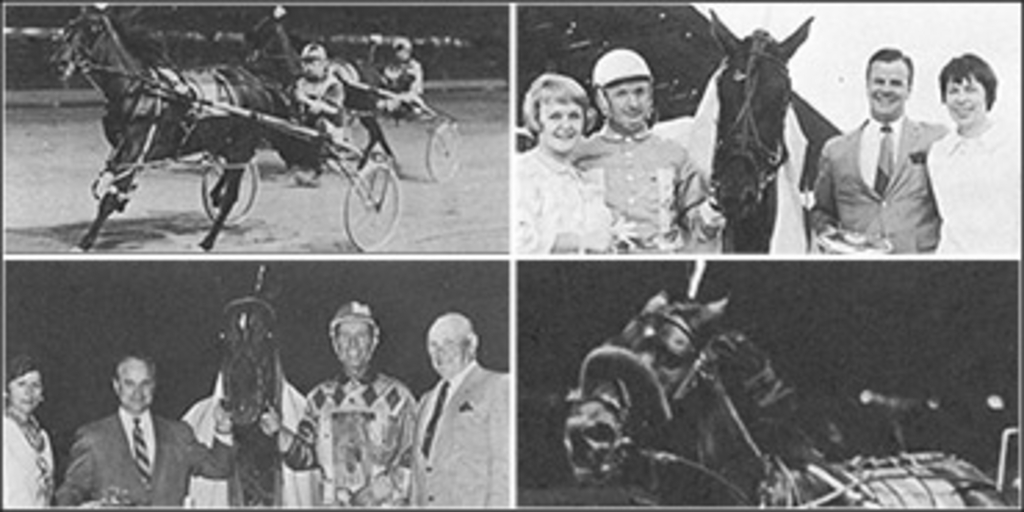
 In this week's Rewind Robert Smith recalls the return of Grand Circuit racing to Toronto after an absence of nearly 35 years.
In this week's Rewind Robert Smith recalls the return of Grand Circuit racing to Toronto after an absence of nearly 35 years.
The "Roarin' Grand" as it was often called made a memorable visit to Greenwood Raceway for a week-long stay in July of 1969. A number of old photographs featuring winning horses from the 1969 races along with owners and drivers accompany today's offering.

A quartet of winning drivers who participated in the 1969 Grand Circuit meeting at Greenwood. From left: Joe O'Brien, Keith Waples, Billy Haughton and Delvin Miller
Way back in 1871 the Grand Circuit of harness racing was formed. Its purpose was to provide owners and trainers of harness horses an opportunity for continuous competition at tracks conveniently accessible to each other. The schedule would be such that successive stops would extend over weeks or even months of activity. The level of excellence was intended to draw the absolute best in the sport. In the early years virtually all record setting performances occurred during Grand Circuit meetings. A couple of examples were the first ever Hambletonian in 1926 and the sport's first two-minute mile in 1897, both a part of G.C. action.
The man credited with the idea was a perceptive Cleveland track owner named Colonel Billy Edwards. His inspiration was said to have come from a very early Canadian circuit which ran only a couple of years. Two years after his idea was planted, it became a reality as Cleveland, Utica N.Y., Buffalo and Springfield, Mass. held the first meetings. Since that time it has survived the depression, a couple of World Wars and yes, even crusades against wagering, to become the premier attraction of harness racing. At one time or another, more than sixty cities have hosted the Grand Circuit. In the beginning, racing was held exclusively over mile tracks, but in 1911 the Historic Track at Goshen, N.Y., a half mile oval was enrolled. By 1947 it was a coast-to-coast show as Hollywood Park in California joined the alliance.
From a historic perspective the Grand Circuit is older than nearly all professional sports. It precedes the first official professional baseball league and easily outdistances all other major sports of today such as pro hockey, basketball and football.
While Grand Circuit meetings started on U.S. soil, they eventually made their way to Canada. The very first appearance was under rather strange circumstances. When an angry populace in Buffalo, N.Y. strongly objected to races which involved gambling being held in their territory, organizers made a logical decision. They simply moved the show across the river to Fort Erie where the Canadian audience was a bit more tolerant. That was in 1898. Huge throngs from Buffalo still attended, travelling by ferry boat, rowboat, train and even horse and buggy. Historic photos of the steamer called "Union" showed buggy owners holding their horses on the windy prow of the old sidewheeler crossing the Niagara River.
Old records show that early in the 1900's the Grand Circuit also had stands at other Canadian sites such as Goderich and London. In 1914, Blue Bonnets Raceway in Montreal hosted the G. C. and in 1924 Windsor's Devonshire Park held a big get-together. It was not until 1932 that the races reached Toronto with meetings held at Thorncliffe Park featuring pari-mutuel wagering. They returned again in both 1934 and 1935 but that was it for Ontario's Capital city until 1969.
On July 14, 1969 the Grand Circuit made a triumphant return to Toronto as it had done some 35 years earlier. The site chosen was the then-tremendously popular Greenwood Raceway. A series of new races were created to supplement some already in existence; several with a former standout performer as the inspiration. Spread throughout the week were eight races, split evenly by gaits. The headline events of the week were The Greenwood Stakes for trotters and Queen City Stakes, both for three-year-olds and each for a purse of $15,000 added.
The return of the Grand Circuit to Toronto and Montreal marked an important step in Canadian racing history. The sport was experiencing a huge upsurge as the decade closed. While the purses do not seem large by today's standards they were back then. Also the Ontario Sires Stakes had not yet been introduced so this was another opportunity for owners of young horses. Many names were engraved into history.
Crowds totalling over 57,000 strong attended this exciting week of racing; it was a memorable time. I am certain there are still numerous people in the reading audience who were in attendance at some or all of the week's races. I have listed below the major winners and included some related photographs.
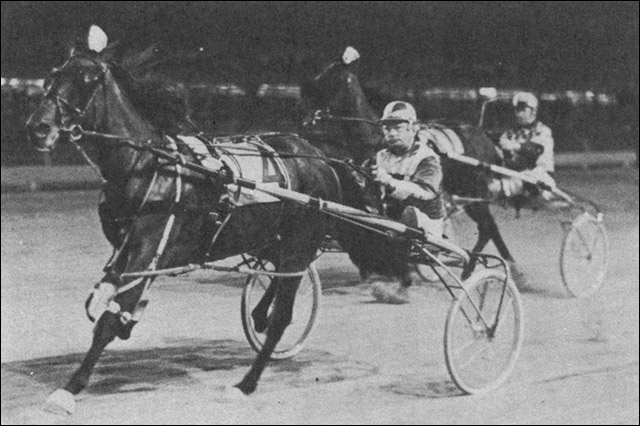
Billy Haughton reins Lana Hill, a two‑year‑old daughter of Knight Time, to a 2:06 2/5 clocking in the second division of the Miss Vera Bars Stakes. Edward Marshall Boehm, Inc. owns the pacing filly which banked the winner's share of the $8,800 event held July 14. Second was Bardot Hanover (K. Waples) with Buckeye Betty third for Vernon Crank. (Harness Horse photo)
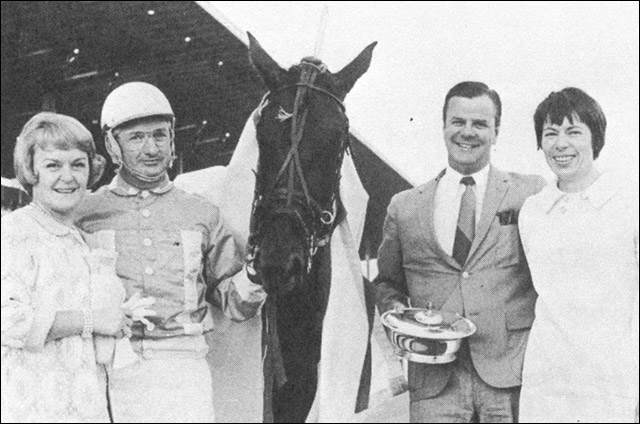
Joe O'Brien holds Demipride after she took her record and $6,000 in the $8,000 "In Free" stakes for two‑year‑old trotting fillies. Only Harry Harvey, behind Rose Garland challenged the Star's Pride‑Demolou lass. The two‑horse event held July 15 went in 2:16 1/5. Bill Stephenson, sports director of a local radio station, and Audrey (Mrs. Harold) McKinley (right) make the trophy presentation to Joe and his wife Eileen. (Harness Horse)
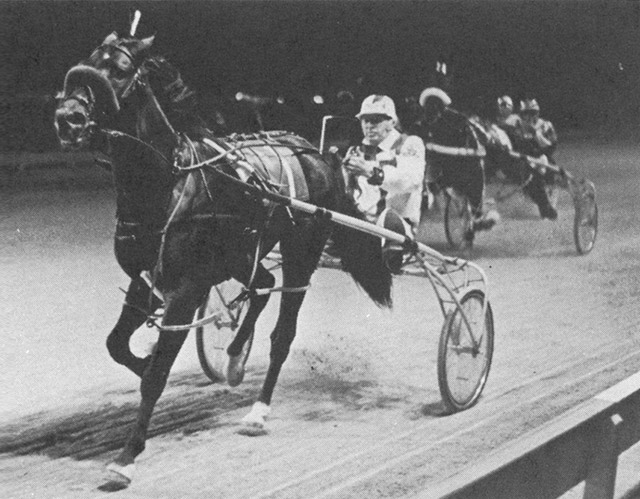
Super Wave, George Boyce's superb bay son of Shadow Wave, concludes the Grand Circuit action at Greenwood with a 3 ½ length tally in 2:03 1/5 in the $17,900 Queen City Stakes. Second was Penn Hanover (John Hayes) with Mizelles Mickey (Ben Steall) third. (Harness Horse)
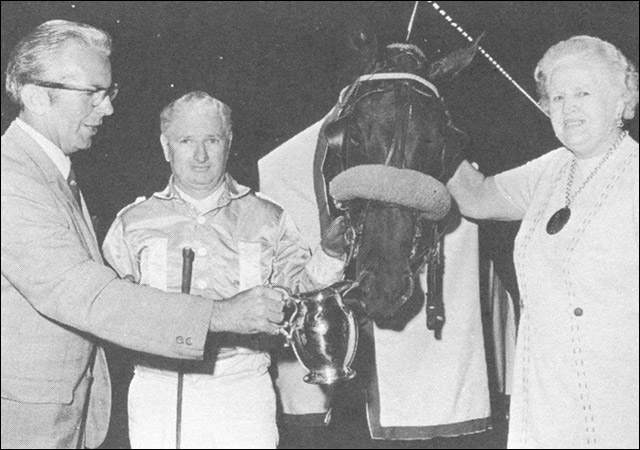
Armbro Kerry took care of competition in the $8,700 first division of the Miss Vera Bars Stakes. Joe O'Brien holds the two‑year‑old daughter of Tar Heel‑Dotties Pick after her 2:04 3/5 effort in the juvenile filly pacing event.Toronto Telegram sports columnist Bob Pennington made the winner's cup presentation to Mrs. Victoria Armstrong. Second was Dag Mir (Gilles Gendron) and third place went to Ideal Donut (Jim MacGregor) (Harness Horse)
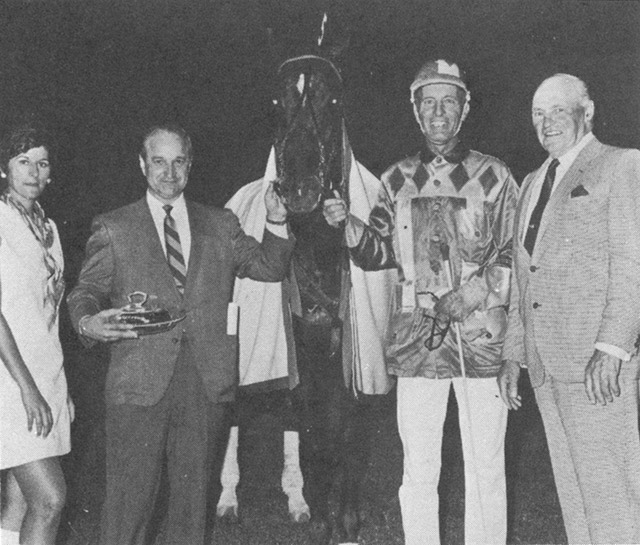
Marbuck Stables' Boncris won the $11,300 Van Riddell two‑year‑old trot stake, July 15th, set a new track record for age, sex, and gait, and lowered his lifetime dash record. John Schroeder was at the controls as the son of John A. Hanover went a 2:09 trip, defeating four other juvenile hopefuls. In the winners circle Sharon Semonick, Grand Circuit Week hostess, welcomes Floyd Betters, representative of the winning stable, driver Schroeder and former Lieutenant Governor of the Province of Ontario. W. Earl Rowe on the far right. (Harness Horse)
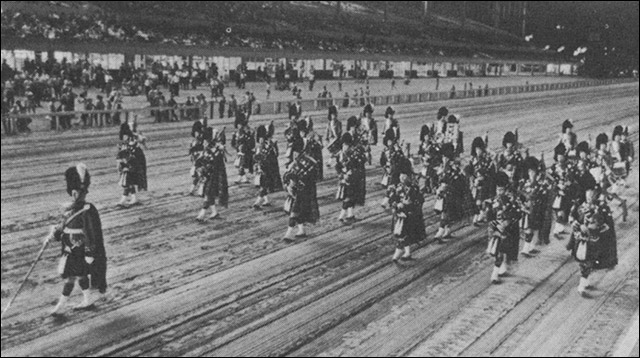
Adding color to the excitement of the Grand Circuit's first visit to Toronto since the mid‑thirties was a succession of bands dressage demonstrations, and fashion shows. This group is Canada's famed 48th Highlanders pipe‑and‑drum band performing before a throng of 10,893 Friday night, July 18. (Harness Horse)
Other Grand Circuit Winners:
-
Constance Scott Stake - Won by Tarport Birdie (Delvin Miller), Saralee Hanover - 2 (Cecil Champion), Armbro Jodie - 3 (J. O'Brien)
-
The Count B. Stake - Won by Romalong (Keith Waples), Express G - 2 (Ken McElroy), Ideal Donut - 3 (J. MacGregor)
-
Celias Counsel Stake - Won by Parula (Stanley Dancer), Gayest Hanover - 2 (Bob Silliphant), Tarport Farr - 3 (Del Miller)
-
Greenwood Trotting Stake - Won by Tarport Reward (Gary Cameron), Armbro Jet - 2 (J. O'Brien), Wealthy- 3 (G. LaMarre)
My thanks to Bill Galvin, O.J.C. Publicist and now Hall of Fame scribe, who did a great deal of research on Grand Circuit history back in 1969. Also appreciated are the old photos supplied by Don Daniels via the Harness Horse magazine.

